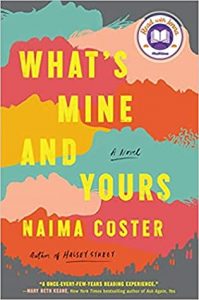
Hispanic Heritage Month
Hispanic Heritage Month runs from September 15 – October 15. It is a month for recognizing the contributions and influence of Hispanic Americans to the history, culture, and achievements of the United States. At the library, we are celebrating the rich literary heritage of Hispanic and Latinx authors. Be sure to check out our library display, but in the meantime, here are a few of our favorites:
Jessica recommends:
 In Lost Children Archive, a family – mother, father, boy and girl, as they are referred to throughout the first part of the book – are embarking on a trip across the U.S. from their apartment where they live in New York City to the borderlands of Arizona. The mother and father both work as sound documentarians, or as the boy points out “one is a documentarian, one is a documentarist,” but both essentially collect sounds for the purposes of making some sort of record of an environment or a story. The father has decided that his new project will be to record the sounds of the land that was once the province of the Apache tribe there. The mother, in order for this trip to make sense for her, decides she must develop a project and, after having worked with immigrant families and hearing the stories of the children lost at the border, decides that she will document the stories of these children and the experiences of the immigrants at the border. The journey takes them weeks, and most of the novel is concerned with their many stops along the way, at various diners and motels, and how they entertain themselves at each place, the stories they tell – the father: stories of the Apache Chiefs and the brave figures in the tribe; the mother, stories real and fictional of lost children around the world.
In Lost Children Archive, a family – mother, father, boy and girl, as they are referred to throughout the first part of the book – are embarking on a trip across the U.S. from their apartment where they live in New York City to the borderlands of Arizona. The mother and father both work as sound documentarians, or as the boy points out “one is a documentarian, one is a documentarist,” but both essentially collect sounds for the purposes of making some sort of record of an environment or a story. The father has decided that his new project will be to record the sounds of the land that was once the province of the Apache tribe there. The mother, in order for this trip to make sense for her, decides she must develop a project and, after having worked with immigrant families and hearing the stories of the children lost at the border, decides that she will document the stories of these children and the experiences of the immigrants at the border. The journey takes them weeks, and most of the novel is concerned with their many stops along the way, at various diners and motels, and how they entertain themselves at each place, the stories they tell – the father: stories of the Apache Chiefs and the brave figures in the tribe; the mother, stories real and fictional of lost children around the world.
What is most resonant about this book though is the language, Luiselli’s ability to create such deep inner struggle: How do we tell the story of these children, and, as pressing as it may be, is it even her story to tell? Those questions are never fully answered, but the story does rapidly become urgent around the last third of the novel. It’s a powerful and resonant read.
 What’s Mine and Yours, by Dominican American author Naima Coster, is a moving story of love and pain that is passed through the generations of two North Carolina families. In 1992, Ray is a baker with big plans for his new cafe. He’s also caring for a young woman named Jade and her son Gee. When we meet Ray, he’s with Gee, getting ready for a visit from a reporter who will write a profile about the café for the newspaper and the future is bright. But then tragedy strikes when Ray and Gee follow Jade to a cousin’s house where he finds himself in the middle of someone else’s debt dispute and is murdered. In another part of town, Lacey May Ventura is a young mother trying her best to raise her three daughters while facing poverty during her husband’s incarceration. On the surface there appears to be little to connect the two families, but flash forward twenty years and we learn the dynamics that have drawn the two families together, mostly through a school integration battle that divided the town, and the relationship between Gee and the eldest Ventura girl, Noelle. This novel tackles a range of issues including class and race, but it’s the characters in the novel that I found so richly dimensioned and moving. I would highly recommend this for people that read and liked An American Marriage, Little Fires Everywhere, or The Vanishing Half.
What’s Mine and Yours, by Dominican American author Naima Coster, is a moving story of love and pain that is passed through the generations of two North Carolina families. In 1992, Ray is a baker with big plans for his new cafe. He’s also caring for a young woman named Jade and her son Gee. When we meet Ray, he’s with Gee, getting ready for a visit from a reporter who will write a profile about the café for the newspaper and the future is bright. But then tragedy strikes when Ray and Gee follow Jade to a cousin’s house where he finds himself in the middle of someone else’s debt dispute and is murdered. In another part of town, Lacey May Ventura is a young mother trying her best to raise her three daughters while facing poverty during her husband’s incarceration. On the surface there appears to be little to connect the two families, but flash forward twenty years and we learn the dynamics that have drawn the two families together, mostly through a school integration battle that divided the town, and the relationship between Gee and the eldest Ventura girl, Noelle. This novel tackles a range of issues including class and race, but it’s the characters in the novel that I found so richly dimensioned and moving. I would highly recommend this for people that read and liked An American Marriage, Little Fires Everywhere, or The Vanishing Half.
Deanna recommends:
 Silvia Moreno-Garcia is the author of Mexican Gothic, a story set in 1950’s Mexico, where she uses all the usual elements of a gothic tale, but with a twist to take the genre in a new direction. Now she is back with Velvet Was the Night, where she is doing the same thing with noir mystery fiction. Noir blends the lines between good and bad, right and wrong; the main character, usually more antihero than hero, is trapped in a difficult situation; and it is usually set against a backdrop of political or institutional corruption. This story is set during the civil unrest in Mexico in the early 1970’s. Maite is a young woman, working as a law secretary, taking refuge in vinyl records and pulp romance fiction. Her neighbor Leonora asks her to watch her cat for a weekend, but then never returns. Not wanting to be responsible for the cat, and wanting to be paid for the job, she goes looking for her. Elvis (not his real name!) is a member of the Hawks, an unofficial agency charged with suppressing student uprisings by whatever means necessary. He is also looking for Leonora, who has photographs that his boss wants back. The story goes back and forth between Maite and Elvis and their paths draw closer and closer together. They are two imperfect and interesting characters – Elvis is a glorified street thug, but yearns to do something more with his life; Maite sometimes has trouble distinguishing between real life and the pulp romances that she loves. Moreno-Garcia has again taken a well-established genre and made it her own. If you like the classic noir authors, if you like Scandinavian noir made popular by The Girl with the Dragon Tattoo, or if you liked Mexican Gothic – then try Velvet Was the Night.
Silvia Moreno-Garcia is the author of Mexican Gothic, a story set in 1950’s Mexico, where she uses all the usual elements of a gothic tale, but with a twist to take the genre in a new direction. Now she is back with Velvet Was the Night, where she is doing the same thing with noir mystery fiction. Noir blends the lines between good and bad, right and wrong; the main character, usually more antihero than hero, is trapped in a difficult situation; and it is usually set against a backdrop of political or institutional corruption. This story is set during the civil unrest in Mexico in the early 1970’s. Maite is a young woman, working as a law secretary, taking refuge in vinyl records and pulp romance fiction. Her neighbor Leonora asks her to watch her cat for a weekend, but then never returns. Not wanting to be responsible for the cat, and wanting to be paid for the job, she goes looking for her. Elvis (not his real name!) is a member of the Hawks, an unofficial agency charged with suppressing student uprisings by whatever means necessary. He is also looking for Leonora, who has photographs that his boss wants back. The story goes back and forth between Maite and Elvis and their paths draw closer and closer together. They are two imperfect and interesting characters – Elvis is a glorified street thug, but yearns to do something more with his life; Maite sometimes has trouble distinguishing between real life and the pulp romances that she loves. Moreno-Garcia has again taken a well-established genre and made it her own. If you like the classic noir authors, if you like Scandinavian noir made popular by The Girl with the Dragon Tattoo, or if you liked Mexican Gothic – then try Velvet Was the Night.
Laura recommends:
 De Robertis’ Cantoras is a bold telling of queerness under the civic-military dictatorship of Uruguay in the 1970s and 1980s. The book follows five queer women, or cantoras as lesbians where then called, of varying ages as they move through Montevideo in quite separate ways but remain united due to their unabashed desire to be themselves—at least with each other. This desire sparks the five to buy a small seaside shack on the eastern coast of Cabo Polonio where seclusion permits promiscuity and self-discovery. The women’s relationships continually shift between lover, mentor, adversary, protector, and conspirator. Over the slow pull of maté, the woman share whispers of ache and yearning hushed like the quiet sweeping of sea salt dusted floors. This set against the harsh and constant threat of violence and the fear of unveiling trauma long buried is where Cantoras best displays the stark realities of the time. Throughout, De Robertis weaves an intricate narrative about chosen family and agency, about power and corruption, about what it means to belong and to be longed for.
De Robertis’ Cantoras is a bold telling of queerness under the civic-military dictatorship of Uruguay in the 1970s and 1980s. The book follows five queer women, or cantoras as lesbians where then called, of varying ages as they move through Montevideo in quite separate ways but remain united due to their unabashed desire to be themselves—at least with each other. This desire sparks the five to buy a small seaside shack on the eastern coast of Cabo Polonio where seclusion permits promiscuity and self-discovery. The women’s relationships continually shift between lover, mentor, adversary, protector, and conspirator. Over the slow pull of maté, the woman share whispers of ache and yearning hushed like the quiet sweeping of sea salt dusted floors. This set against the harsh and constant threat of violence and the fear of unveiling trauma long buried is where Cantoras best displays the stark realities of the time. Throughout, De Robertis weaves an intricate narrative about chosen family and agency, about power and corruption, about what it means to belong and to be longed for.






